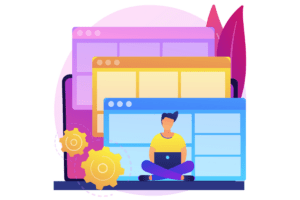A strong lead generation strategy will help your company increase revenue, and ultimately grow. However, we all know that lead generation is not as easy as it sounds. Even veteran marketers can struggle to perfect their lead generation strategy. A lot of the time, marketers struggle to understand why their leads are not converting. While it can be a lot of trial and error, there are a few common reasons as to why your leads could not be converting. Keep reading for the 12 most common reasons why your leads are not converting.
1. Not Qualified
Not all leads are made equal. This is a hard pill to swallow for new or inexperienced marketers, who want to convert every email or phone number they find. But, not every lead you generate will be qualified. I commonly see this when marketers buy an email list from a source that is not trustworthy. They purchase thousands of “leads”, that end up being random or dead email addresses that are not actually interested in what you have to offer. But, just because someone isn’t qualified now, doesn’t mean that they will never be qualified.
2. Not Ready
Encouraging a lead to follow through your sales funnel is hard work. But, if you try to convert them too early, they might end up falling out of your funnel. Reaching out too early can make you seem too pushy or like you’re not listening to their needs. As an example, if it takes your company an average of two client meetings prior to them converting, and you try to convert them immediately after the first client meeting, they might have a negative response. It can take a lot of trial and error to find out what the perfect time to reach out and close the deal is.
3. Interested in a Competitor
Prospects are often in the position of choosing between multiple options. All of the options will satisfy their needs to one extent or another, but which will they choose? Often price, customer support, accessibility, and how easy it is to use are key factors. If you know that your company is more expensive than a competitor your prospect is interested in, show them all of the extra features that they will get for that price difference. Or, even offer them a best price guarantee promotion to entice them to choose you over your competitors.
4. Has too Many Questions
When a company is getting ready to spend thousands of dollars, they will not convert if they have a dozen unanswered questions. This is why it’s important to ask along the way if they have any questions. If you wait until after your second meeting to ask, they could have forgotten some along the way. As a result, they might lack confidence in your product and company. To make it more organic, ask if certain points you have are making sense to them, if they understood, in addition to asking if they have any questions. It can also help to encourage them to ask questions by closing your emails with “If you have any questions or concerns along the way, don’t hesitate to reach out,”.

5. Negative Demo Experience
Your software demo is one of the most critical points in your sales process. If the demo doesn’t go very well, there is a good chance that the lead will not convert. Whether your demo is in-person or over Zoom, it’s important to be well-prepared. Prior to your demo, it’s helpful to check out the company’s LinkedIn, as well as the LinkedIn profile of the people you’re meeting with. This will help you understand how the company will use your software, and anticipate questions that they will have. If you are doing your demo over Zoom, ensure that your internet connection is reliable and that you’re not going to have any technical difficulties during the demo. If you do have technical difficulties, it can be awkward, but looking at your prospect’s LinkedIn can help you come up with ice breaker questions.
6. No Personalization
Personalization is everything in 2022. Without personalization, a company can easily fall behind their competitors that are utilizing personalization. And, it’s much more than addressing your prospect by their first name in an email. Personalization can include website personalization with optimized landing pages, remarketing ads, customized software demos, social selling, and more. The more personalized you can make your communications feel, the better. This is especially true with so many individuals working from home and unable to attend in-person meetings.
7. Pushing Them Through Your Sales Funnel Too Quickly
It’s amazing if you are able to speed up your sales cycle and gain a quick sale, but, unfortunately it doesn’t always work out that way. Pushing a prospect through your sales funnel too quickly is likely to lead to a lot of confusion, questions, or the prospect feeling like you’re just trying to get a sale rather than helping them. And, this can leave the prospect feeling overwhelmed and not wanting to convert. It can take some time to understand how quickly the average lead flows through your sales funnel, but do your best to not rush them in order to make a quick sale.

8. There’s an Issue on Your Website
An issue on your website is a marketer’s nightmare. In some cases, it can take days or even weeks before you realize there is an issue. By that time, you could have lost dozens of leads. That is why it’s so important to regularly check your Google Analytics account for drastic changes. If you’re not sure if you have any bugs or other issues that could prevent your leads from converting, a tool called Hotjar is very helpful. Hotjar has a few helpful features, including heat maps and session recordings. Heatmaps show you where your website visitors are clicking and engaging, while session recordings show you recordings of website visits. These allow you to easily see bugs, errors, visitors that are confused, potential optimizations, and other issues that could help you convert more of your website visitors.
9. Not Following Up at the Right Time
Following up is almost a science. Too early, too late, different time zones, not enough information, too much information, preferences, and many other considerations go into following up at the right time with your prospects. In order to follow up at the right time, you can use your CRM. When a prospect completes a task, like having a demo, you can automate your CRM to follow up with them. Far too often a salesperson will forget to follow up, and ends up sending their follow up email at 5pm.
10. Not Using Omni-Channel Marketing
During your prospect’s journey down your sales funnel, they will take an average of eight touchpoints before they convert. This could include visits to your website, demos, phone calls, browsing your social media channels, or various other forms of communication. Because there are so many different places they can find information, it’s essential that your company is using omni-channel marketing. Omni-channel marketing refers to the practice of aligning your company’s sales and marketing efforts across the board. So, if someone looks at your company’s LinkedIn page, they will know right away that it’s yours, even before they see the logo. Of course, not every channel requires the exact same messaging, but it’s important to ensure your content is recognizable.
11. Poor Quality Landing Pages
Just because we are calling this reason “poor”, doesn’t inherently mean that your landing pages are bad. They just might not be optimized with your specific audience in mind and could be the very reason why your leads are not converting. Even something as small as changing where a call to action is placed on the page might encourage more conversions. A/B testing different versions of your landing pages is a great way to ensure your content is the best version it can be. If you want to make quick changes to your landing pages, Google Optimize is a great tool if you’re not a coding wizard. With Google Optimize, you can change the layout, add pop ups, banners, and change up your call to action.
12. Negative Reviews
93% of B2B customers read reviews before purchasing. More than likely, the prospect will sort your reviews lowest to highest, meaning they will see any negative reviews first. If you have a number of reviews that are three stars or less, it could be the deciding factor for a prospect. If you’re worried about your online reputation, it’s a good idea to reply to all of your reviews, even the positive ones. Thank them for their feedback, and give them options, advice, contact information, help documents, and other relevant information that will solve their complaints. By providing your reviewers with this information, you are more likely to retain them as a customer, and make a good impression on leads that are not converting or are on the fence.
Want to Generate Qualified Leads That Are Ready To Convert?
We all know that generating qualified leads that are ready to convert is virtually impossible. Or is it? With Visitor Queue, you can do just that. Visitor Queue is a B2B lead generation software that can identify the companies that visit your website. View each company’s visit history, an overview, link to their website, and more information to help you qualify them in seconds. We provide visit information like how they were acquired, what pages they viewed, and how long they spent on each page. In addition, we also provide employee email addresses, phone numbers, and LinkedIn channels to help you reach out. My favorite way to use Visitor Queue is to view the companies that visit our pricing page. Start your 14-day free trial of Visitor Queue and stop losing leads.
Final Words
As you can see, there are a number of factors that go into a lead converting or not. It can take a lot of trial and error to perfect your sales cycle, and reduce the number of leads that are not converting. Keep in mind that every lead you generate will not always be qualified. If you have any questions about how to generate highly qualified leads that are ready to convert with Visitor Queue, let us know!
 Identify
Identify Personalize
Personalize Benchmark
Benchmark Agencies
Agencies Integrations
Integrations Case Studies
Case Studies Use Cases
Use Cases Blog
Blog Resources
Resources









